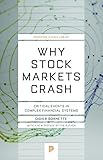Why stock markets crash : critical events in complex financial systems / Didier Sornette ; with a new preface by the author.
Material type: TextSeries: Publication details: Princeton, New Jersey : Princeton University Press, (c)2017.Description: 1 online resourceContent type:
TextSeries: Publication details: Princeton, New Jersey : Princeton University Press, (c)2017.Description: 1 online resourceContent type: - text
- computer
- online resource
- 9781400885091
- HB3722 .W497 2017
- COPYRIGHT NOT covered - Click this link to request copyright permission: https://lib.ciu.edu/copyright-request-form
| Item type | Current library | Collection | Call number | URL | Status | Date due | Barcode | |
|---|---|---|---|---|---|---|---|---|
 Online Book (LOGIN USING YOUR MY CIU LOGIN AND PASSWORD)
Online Book (LOGIN USING YOUR MY CIU LOGIN AND PASSWORD)
|
G. Allen Fleece Library ONLINE | Non-fiction | HB3722 (Browse shelf(Opens below)) | Link to resource | Available | ocn975485375 |
Includes bibliographies and index.
Cover Page; Title Page; Copyright Page; Contents; Preface to the Princeton Science Library Edition; Preface to the 2002 Edition; Chapter 1: Financial Crashes: What, How, Why, and When?; What Are Crashes, and Why Do We Care?; The Crash of October 1987; Historical Crashes; The Tulip Mania; The South Sea Bubble; The Great Crash of October 1929; Extreme Events in Complex Systems; Is Prediction Possible? A Working Hypothesis; Chapter 2: Fundamentals of Financial Markets; The Basics; Price Trajectories; Return Trajectories; Return Distributions and Return Correlation
The Efficient Market Hypothesis and the Random WalkThe Random Walk; A Parable: How Information Is Incorporated in Prices, Thus Destroying Potential "Free Lunches"; Prices Are Unpredictable, or Are They?; Risk-Return Trade-Off; Chapter 3: Financial Crashes are "Outliers"; What Are "Abnormal" Returns?; Drawdowns (Runs); Definition of Drawdowns; Drawdowns and the Detection of "Outliers"; Expected Distribution of "Normal" Drawdowns; Drawdown Distributions of Stock Market Indices; The Dow Jones Industrial Average; The Nasdaq Composite Index; Further Tests
The Presence of Outliers Is a General PhenomenonMain Stock Market Indices, Currencies, and Gold; Largest U.S. Companies; Synthesis; Symmetry-Breaking on Crash and Rally Days; Implications for Safety Regulations of Stock Markets; Chapter 4: Positive Feedbacks; Feedbacks and Self-Organization in Economics; Hedging Derivatives, Insurance Portfolios, and Rational Panics; "Herd" Behavior and "Crowd" Effect; Behavioral Economics; Herding; Empirical Evidence of Financial Analysts' Herding; Forces of Imitation; It Is Optimal to Imitate When Lacking Information; Mimetic Contagion and the Urn Models
Imitation from Evolutionary PsychologyRumors; The Survival of the Fittest Idea; Gambling Spirits; "Anti-Imitation" and Self-Organization; Why It May Pay to Be in the Minority; El-Farol's Bar Problem; Minority Games; Imitation versus Contrarian Behavior; Cooperative Behaviors Resulting from Imitation; The Ising Model of Cooperative Behavior; Complex Evolutionary Adaptive Systems of Boundedly Rational Agents; Chapter 5: Modeling Financial Bubbles and Market Crashes; What Is a Model?; Strategy for Model Construction in Finance; Basic Principles; The Principle of Absence of Arbitrage Opportunity
Existence of Rational Agents"Rational Bubbles" and Goldstone Modes of the Price "Parity Symmetry" Breaking; Price Parity Symmetry; Speculation as Spontaneous Symmetry Breaking; Basic Ingredients of the Two Models; The Risk-Driven Model; Summary of the Main Properties of the Model; The Crash Hazard Rate Drives the Market Price; Imitation and Herding Drive the Crash Hazard Rate; The Price-Driven Model; Imitation and Herding Drive the Market Price; The Price Return Drives the Crash Hazard Rate; Risk-Driven versus Price-Driven Models
COPYRIGHT NOT covered - Click this link to request copyright permission:
There are no comments on this title.
